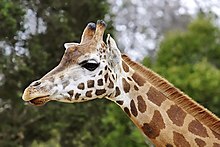m I have added a picture. |
m I have moved a picture. |
||
| Line 17: | Line 17: | ||
}} |
}} |
||
[[image:rgiraffee|thumb|left|Rothscild [[Giraffe]]s at [[Woburn Safari Park]] |
|||
The '''Rothschild Giraffe''', named after [[Walter Rothschild Zoological Museum|Tring Zoological Museum]]'s founder, [[Lord Walter Rothschild]]<ref name=obit>{{Cite web |
The '''Rothschild Giraffe''', named after [[Walter Rothschild Zoological Museum|Tring Zoological Museum]]'s founder, [[Lord Walter Rothschild]]<ref name=obit>{{Cite web |
||
| url = http://www.guardian.co.uk/obituaries/story/0,3604,1589085,00.html |
| url = http://www.guardian.co.uk/obituaries/story/0,3604,1589085,00.html |
||
Revision as of 06:26, 26 June 2007
| Rothschild Giraffe | |
|---|---|

| |
| Scientific classification | |
| Kingdom: | |
| Phylum: | |
| Class: | |
| Order: | |
| Family: | |
| Genus: | |
| Species: | |
| Subspecies: | G. c. rothschildi
|
| Trinomial name | |
| Giraffa camelopardalis rothschildi | |

| |
| Range map | |
The Rothschild Giraffe, named after Tring Zoological Museum's founder, Lord Walter Rothschild[1], also known as the Baringo Giraffe, after the Lake Baringo area of Kenya[2], or as the Ugandan Giraffe, is the most endangered of giraffe subspecies[3], with around forty believed to exist in the wild.[4] While giraffes in general are classified as Lower Risk: Conservation Dependent, the Rothschild Giraffe is at particular risk of hybridisation, as the population is so limited in numbers. There are very few locations where the Rothschild Giraffe can be seen in the wild, with notable hotspots being Lake Nakuru National Park in Kenya[5] and Murchison Falls National Park[6] in Northern Uganda. There are various captive breeding programmes in place - most notably at The Giraffe Centre in Nairobi, Kenya, and at Woburn Safari Park in Bedfordshire, England - which aim to expand the genetic gene-pool in the wild population of the Rothschild Giraffe.
Rothschild Giraffes are easily distinguishable from other subspecies. The most obvious visible sign is in the colouring of the coat, or pelt. Where the Reticulated Giraffe has very clearly defined dark patches with bright white channels between them, the Rothschild Giraffe more resembles the Masai Giraffe. However, when compared to the Masai Giraffe, the Rothschild subspecies is paler, and the orange-brown patches are less jagged, with a creamier channel between patches than the Reticulated Giraffe. In addition, the Rothschild Giraffe displays no markings on the lower leg, giving the impression that it is wearing white stockings.[1]
Another distinguishing feature of the Rothschild Giraffe, although harder to distinguish, is the number of horns on the head. This is the only subspecies to be born with five 'horns'. Two of these are 'true' horns at the top of the head, in common with all giraffes. The third 'horn' can often be seen in the centre of the giraffe's forehead and the other two behind each ear.[7] They are also taller than many other subspecies, measuring up to six metres tall (20 ft).[1]
Rothschild Giraffes can mate at any time of the year, and have a gestation period of between 14 and 16 months, with one calf being born. They live in small herds, with males and females (and their calves) living separately, only mixing for mating purposes.[7]
Males are larger than females and their two 'true' horns are usually bald from sparring. They also tend to be darker in colour than the females, although this is not a guaranteed sexing indicator.
References
- ^ a b c "Obituary - Betty Leslie-Melville". The Guardian. 2005-10-11. Retrieved 2007-04-19.
- ^ Eric O. Odada. "Lake Baringo" (PDF). Retrieved 2007-04-19.
- ^ "News - Christmas Baby makes New Year debut at Woburn Safari Park - 10th January". Woburn Safari Park. Retrieved 2007-04-19.
- ^ "Animal facts - Rothschild giraffe". Woburn Safari Park. Retrieved 2007-04-20.
- ^ "Lake Nakuru National Park". UNESCO. Retrieved 2007-04-19.
- ^ "National Parks & Safaris". Uganda Tourist Board. Retrieved 2007-05-09.
- ^ a b "ROTHSCHILD GIRAFFE - Giraffa camelopardalis rothschildi" (PDF). Zoological Parks and Gardens Board of Victoria. Retrieved 2007-04-19.